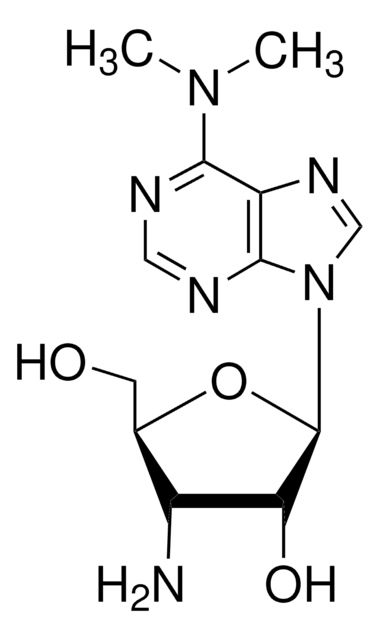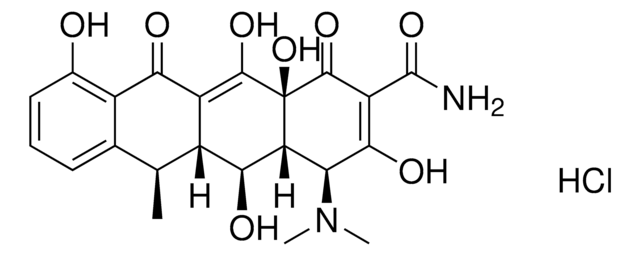SBR00017
Puromycin aminonucleoside Ready Made Solution
10 mg/mL in water
Synonyme(s) :
3′-Amino-3′-deoxy-N6,N6-dimethyladenosine
About This Item
Produits recommandés
Essai
≥98%
Niveau de qualité
Forme
liquid
Concentration
10 mg/mL in water
Spectre d'activité de l'antibiotique
Gram-positive bacteria
neoplastics
parasites
Mode d’action
protein synthesis | interferes
Température de stockage
2-8°C
Chaîne SMILES
N[C@H]1[C@@H](O)[C@H](N(C=N2)C3=C2C(N(C)C)=NC=N3)O[C@@H]1CO
InChI
1S/C12H18N6O3/c1-17(2)10-8-11(15-4-14-10)18(5-16-8)12-9(20)7(13)6(3-19)21-12/h4-7,9,12,19-20H,3,13H2,1-2H3
Clé InChI
RYSMHWILUNYBFW-UHFFFAOYSA-N
Actions biochimiques/physiologiques
Puromycin aminonucleoside has also been used to probe endothelial glycosaminoglycan synthesis in cultured glomerular endothelial cells and their relation to cell permeability. A puromycin aminonucleoside nephrosis model of rat glomerular disease was also used to study the role of the neuron-specific ubiquitin C-terminal hydrolase protein gene product 9.5 (PGP 9.5).
Notes préparatoires
Code de la classe de stockage
10 - Combustible liquids
Classe de danger pour l'eau (WGK)
WGK 2
Point d'éclair (°F)
Not applicable
Point d'éclair (°C)
Not applicable
Faites votre choix parmi les versions les plus récentes :
Certificats d'analyse (COA)
Vous ne trouvez pas la bonne version ?
Si vous avez besoin d'une version particulière, vous pouvez rechercher un certificat spécifique par le numéro de lot.
Déjà en possession de ce produit ?
Retrouvez la documentation relative aux produits que vous avez récemment achetés dans la Bibliothèque de documents.
Les clients ont également consulté
Notre équipe de scientifiques dispose d'une expérience dans tous les secteurs de la recherche, notamment en sciences de la vie, science des matériaux, synthèse chimique, chromatographie, analyse et dans de nombreux autres domaines..
Contacter notre Service technique









